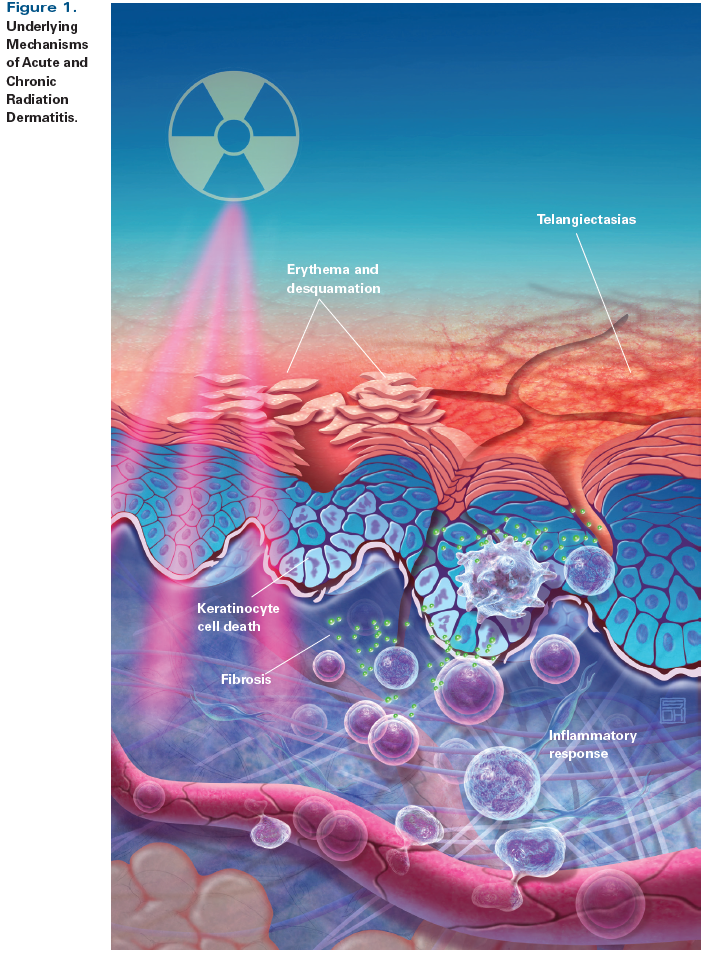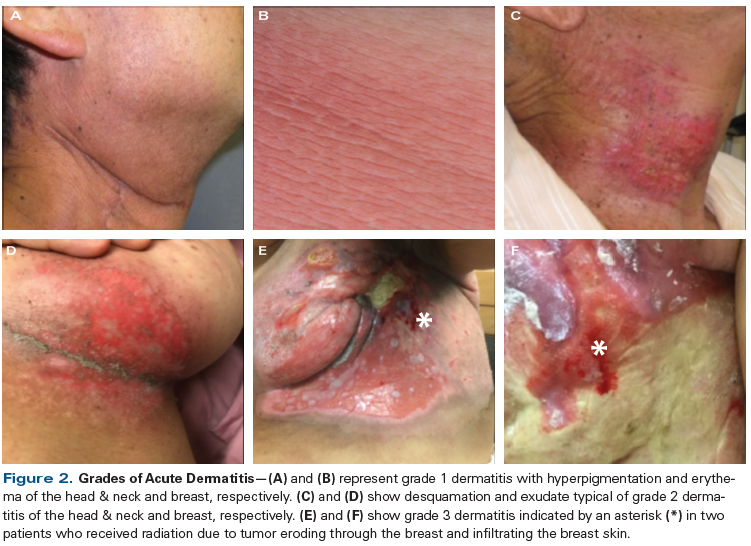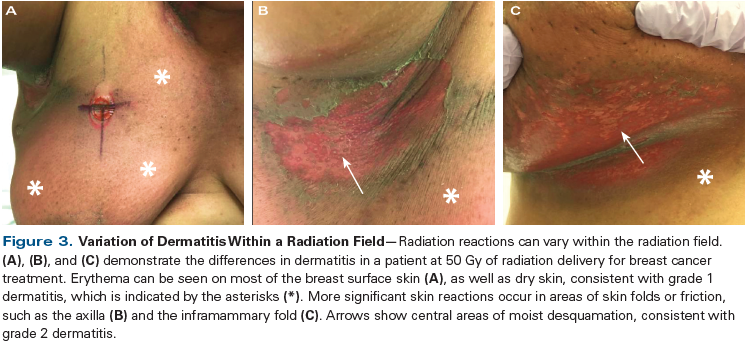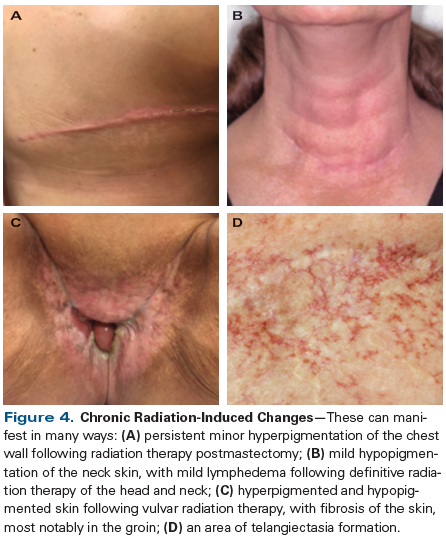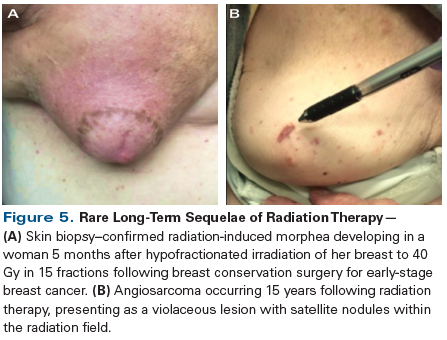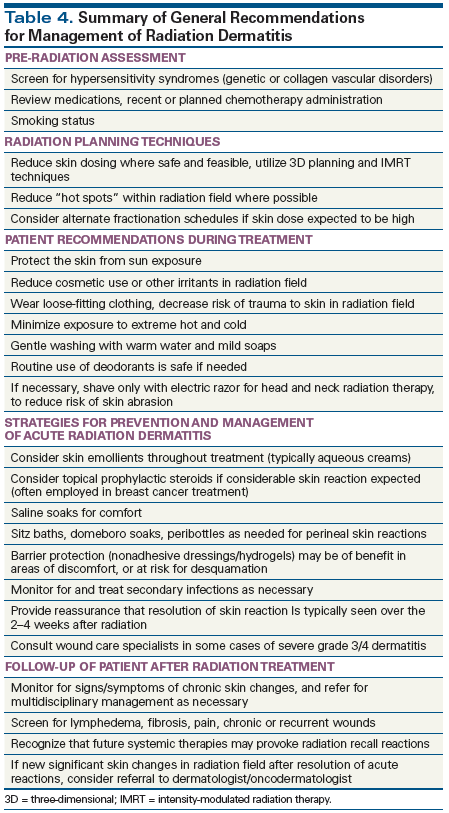Radiation therapy (RT) is a frequently used modality for cancer treatment. Acute and/or chronic skin changes may occur and carry risk of influencing quality of life during and after completion of RT. Radiation reactions may lead to delays in treatment, diminished cosmesis, and functional deficits. Lifestyle factors, treatment modalities, topical agents, and, in some cases, wound dressings may be utilized to help prevent or ameliorate radiation-induced skin reactions. While rigorous evidence supporting specific interventions may be lacking or contradictory, this article summarizes the current knowledge of the etiology, manifestations, and interventions available for prevention and management of radiation dermatitis. Further well-designed studies are needed to confirm the efficacy of current recommendations and facilitate development of novel strategies for optimal care of patients with radiation dermatitis.
Introduction
Radiation therapy (RT) remains an essential component of cancer treatment, with nearly 50% of cancer patients receiving RT at some point during the course of their illness. Of those receiving RT, as many as 95% may experience some form of radiation dermatitis, or radiation-induced skin injury.[1] Radiation dermatitis can manifest as acute erythema and desquamation, or as chronic effects including skin atrophy, telangiectasias, and fibrosis. These skin changes result from a combination of RT features and intrinsic patient risk factors. While a reduced total dose of radiation and use of an advanced mode of radiation delivery may help to mitigate the severity of radiation effects on the skin, radiation dermatitis remains one of the most common side effects of RT. This condition can affect a patient’s quality of life both during and after treatment. If severe, it carries the risk of limiting the dose of radiation or interrupting the treatment schedule, which could negatively impact treatment efficacy. Consequently, managing radiation-induced skin injury during and after treatment is an important aspect of cancer care. Despite technological advances in radiation delivery and growing interest in managing skin reactions, there is no gold standard in the management of radiation dermatitis. This article highlights the typical skin reactions associated with RT, as well as current evidence-based approaches to management and intervention.
Pathophysiology and Clinical Presentation
The high energy x-rays used in modern RT produce both direct and indirect ionization events that not only result in injury to cancer cells, but also pose a risk of injury to normal tissues (Figure 1). Most patients undergoing RT receive small, daily doses of radiation; the clinical goal is to achieve tumor killing after repeated exposure while minimizing harm to healthy surrounding tissue.[2] Inevitably, however, a small fraction of rapidly proliferating cells in the basal layer of the skin are injured or destroyed, precipitating a decrease in the population of differentiated epidermal keratinocytes; this can result in desquamation-ie, the peeling and shedding of the epidermis-depending on the total dose of radiation delivered.[3] Impairment of the skin barrier function carries the risks of wound formation, loss of immune function, and infection. Further, radiation can also damage the microvascular system, increasing the risk of tissue hypoxia and fibrosis, and activating an inflammatory cascade, leading to acute and chronic skin changes.[4-6]
The acute phase of radiation dermatitis is often defined as the changes seen within 90 days following RT. The development of acute radiation dermatitis follows a predictable course (Table 1). While multiple systems exist for the grading of skin effects from RT, the ones most commonly referenced are the Radiation Therapy Oncology Group grading scale and the National Cancer Institute Common Terminology Criteria for Adverse Events, version 4.03 (Table 2).[7,8] Transient, mild erythema can occur within hours of RT, likely due to capillary dilation shortly after patient exposure to radiation. However, the more conventional, sustained hyperpigmentation or erythema associated with RT typically does not occur until 2 to 4 weeks into treatment. Hair follicles and sebaceous glands can be affected early in the course of RT, leading to dry skin and hair loss. As erythema develops, a sunburn-like reaction can ensue, with associated edema, pruritus, tenderness, and a burning sensation. Dry desquamation, which manifests as pruritus and flaking of the skin, may occur 3 to 6 weeks into the RT regimen, at cumulative doses above 20 Gy.[9] With increasing radiation doses above 30 to 40 Gy, patients may develop moist desquamation-a condition that is characterized by tender, red skin associated with serous exudate, hemorrhagic crusting, and the potential for development of bullae.[10] Due to breakdown of the skin barrier, this stage is generally painful. It is characterized by increased susceptibility to contact injury, particularly in flexural areas prone to frictional stress; by infection; and by ulcer formation. In cases of extreme desquamation, clinicians may need to withhold RT for a period of time, to allow for sufficient re-epithelialization before the patient resumes treatment.
Figures 2 and 3 provide examples of different stages of dermatitis and illustrate how varying degrees of dermatitis can occur within the same radiation field. The acute skin reaction typically peaks at 1 to 2 weeks after completion of RT. As the epidermal keratinocytes repopulate and the immune response cascade reverses, the symptoms of acute dermatitis resolve in most patients. The time to resolution of any desquamation, erythema, and edema typically is 2 to 4 weeks following the end of treatment. It is not uncommon for residual postinflammatory hyperpigmentation to persist, but this typically wanes over subsequent months posttreatment.
Chronic radiation dermatitis is typically defined as changes that occur more than 90 days following a course of RT (Figure 4). Chronic skin changes may result from aberrant or dysregulated alterations in proinflammatory and profibrotic cytokines.[4-6,11] These changes may include hypopigmented and/or hyperpigmented skin that persists or develops after resolution of the acute phase of dermatitis. There may be sustained loss of certain skin structures such as sebaceous glands, hair follicles, and nails, as well as textural changes to the skin.[12,13] Thinning or atrophy of the epidermis and dermis may be observed, although some patients may develop induration and thickening of the dermis. Telangiectasia may occur as a result of blood vessel dilation, while damage to blood vessels may also result in tissue hypoxia, predisposing the patient to development of skin ulceration and/or chronic wounds.[14] Radiation-induced fibrosis is a potentially serious sequela of RT that may cause poor cosmesis, lymphedema, skin retraction, persistent hyperpigmentation, and joint immobility.[15-17] In summary, depending on the severity and location of chronic skin changes after RT, there is potential for decreased quality of life due to pain, recurrent wounds, decreased range of motion, and cosmetic dissatisfaction.
Both the likelihood of developing radiation dermatitis and the severity of symptoms are dependent on a variety of factors. These include:
• The proximity of the radiation target to the skin.
• The energy of the radiation used.
• The radiation dose and fractionation schedule of treatment.
• The size of the skin surface area exposed to radiation.
• The presence or absence of radiosensitizing concurrent chemotherapy.
Thus, significant radiation dermatitis is most often seen in patients receiving treatment for sarcoma and cancers of the skin, breast, head and neck, vulva, and anus, since the target area of treatment is often close to the skin, with limited ability to spare the skin from higher doses of radiation exposure (Table 3).[18-21] Certain patient-specific factors can also increase the risk and severity of radiation dermatitis; these include malnutrition, smoking, excessive skin folds, elevated body mass index, underlying vascular or connective tissue disease, and genetic factors such as inherited DNA repair deficiencies (eg, as seen in Fanconi anemia and ataxia-telangiectasia syndromes).[14]
Prevention and Management of Radiation Dermatitis
Advances in the technology of radiation delivery, such as intensity-modulated radiation therapy, can help to minimize radiation-induced skin toxicity in certain tumor types, such as breast cancer.[22-24] However, there are limited prospective randomized data on the use of pharmacologic or supportive care agents, topical or nontopical, for the prevention and treatment of radiation dermatitis. In general, findings are conflicting with regard to the clinical value of topical agents and wound dressings in helping patients avoid or reduce the effects of radiation dermatitis; thus, it is difficult to establish strong evidence-based clinical practice guidelines in the approach to skin care for patients receiving RT. The most commonly employed strategies, many of which are supported by clinical practice, are summarized in the article sections that follow. For some interventions, data from small studies suggest some evidence of benefit (Table 4).
Lifestyle changes
In general, patients are advised to wear loose-fitting clothing to help minimize the effects of friction and unnecessary trauma to the skin within the treatment field. Patients are encouraged to avoid sun exposure, not only by limiting the amount of time spent in direct sunlight, but also by wearing clothing made of high ultraviolet protective factor–rated materials, such as natural tight-weave fabrics and specially made synthetic materials now popular in consumer products such as rash guards. Also discouraged is exposure of the skin to extreme heat and cold, as well as application of cosmetics or other potentially irritating products to the skin area within the treatment field. Shaving of skin within the radiation field should be done with caution; an electric razor should be used to prevent trauma to the skin, and preshave or aftershave agents should be avoided. Use of a straight edge or disposable razor is not advised, due to the risk of trauma to the top layers of skin. While data are mixed in regard to washing with soap and water, a small randomized controlled study showed that breast cancer patients who washed with mild soap and water during RT to the chest wall had reduced severity of erythema and pruritus at the end of treatment.[25] However, a similar study, while reporting a trend toward more acute skin toxicity in the nonwashing group, did not find a statistical difference between groups.[26] Nevertheless, recommendations have evolved to support daily gentle washing with warm water and mild pH-neutral or nonalkaline soaps. While historically discouraged, it is now established that normal use of deodorants or antiperspirants does not appear to be associated with an increased risk of skin reaction during RT.[27,28] In the past, there was concern for a bolus effect with the application of topical agents to the skin prior to RT, which theoretically could enhance the radiation dose delivered to the skin. However, a normal, thin application of topicals, such as deodorants, produces no significant bolus effect; any skin irritation from deodorants within areas such as the axilla is likely to result from irritating chemical ingredients rather than any physical increase in the skin dose.[29]
Topical treatments
Many small studies have investigated the use of topical therapies, as either preventative agents or for management of skin reactions as they occur. Patients are commonly advised to use a skin emollient, or moisturizer, throughout the course of RT-one of the most common being an aqueous cream that is used both as prophylaxis and to treat erythema and dry desquamation.[30] Some centers have also used aloe vera, although several studies suggest that its use has no benefit.[31] Few randomized studies of topical agents for radiation dermatitis exist. However, the phase III Radiation Therapy Oncology Group 97-13 trial compared trolamine, a nonsteroidal anti-inflammatory agent, with best supportive care for women undergoing breast RT. While no difference was seen in the mean maximum grade of radiation dermatitis, the results were confounded by the fact that 85% of patients in the best supportive care arm used aloe vera, Aquaphor, or another topical agent.[32] Other topicals of interest have included hyaluronic acid–based compounds, sucralfate, or calendula-but again, data are limited or conflicting with respect to efficacy or added benefit of these agents compared with best supportive care.[1,28,33,34] Topical corticosteroids have been of interest in the care of radiation dermatitis, given their anti-inflammatory properties. Limited data from prospective randomized trials in patients with breast cancer indicate that the prophylactic application of a medium-potency steroid, mometasone furoate, resulted in less erythema and an improvement in patient-reported outcomes of comfort and pruritus.[18,35,36] Other small studies indicate a potential similar prophylactic benefit for betamethasone, although results have been mixed.[37] In general, prophylactic application of a topical steroid is favored for patients at higher risk of radiation dermatitis, and topical steroids are commonly employed in the treatment of acute cases. Additionally, there is some interest in the use of topical antioxidants or oral enzymes for the prevention of radiation dermatitis, but to date no clear benefit has been shown.[34]
KEY POINTS
- Radiation dermatitis may affect up to 95% of patients receiving radiation therapy (RT), although the intensity and severity of the condition vary greatly, depending on the target of RT and the dose delivered.
- Radiation dermatitis can significantly influence patients’ quality of life during and after completion of RT.
- Strategies to prevent or mitigate radiation dermatitis are aimed at improving comfort during RT, reducing the degree of inflammation, and promoting healing of skin areas with more severe dermatitis.
When radiation dermatitis becomes more significant, particularly if dry and moist desquamation develop, additional strategies for wound care may be used. The key measures include keeping the site clean and moist, protecting the area from contamination and infection, and addressing pain management. A moist environment encourages migration of keratinocytes in the wound bed to help promote healing.[38,39] Saline soaks to areas of skin sensitivity or desquamation can be cleansing and comforting. In cases of perineal skin reactions, the use of sitz baths and perineal irrigation bottles can help patients to avoid perineal abrasion after toileting. Application of dressings may also serve to reduce further contact or mechanical injury to the wound site, while promoting healing. Some of the most frequently used wound dressings include hydrocolloid or hydrogel dressings, soft silicone dressings, and silver-based dressings/ointments. Antimicrobials may be indicated if there are signs of secondary skin infection, and appropriate empiric therapy may be initiated. For patients at high risk of infection, topical antimicrobial agents, such as silver sulfadiazine or silver-based dressings, may be of benefit. The data are mixed regarding the absolute benefit and time to complete wound healing with use of the various products, but in general these agents help to provide barrier protection and a soothing and cooling effect that improves comfort. Occasionally, severe grade 3 and 4 skin reactions may require referral of the patient to centers with experienced wound care professionals, for more advanced management.
Clinically significant chronic dermatitis occurs less frequently than acute dermatitis, but any cancer patient who has undergone RT should still be assessed for this condition during follow-up visits. Depending on the degree of dermal fibrosis, skin breakdown, and lymphedema, the effect of chronic dermatitis on quality of life could range from no effect to significant functional deficits or discomfort. Radiation-induced fibrosis can be challenging to manage, often requiring a multidisciplinary treatment approach that includes physical therapy, wound care, and pain management. Unfortunately, there are limited data to suggest that systemic therapy can reduce or improve fibrosis symptoms once this condition develops. There is some interest in the use of pentoxifylline with or without oral vitamin E for management of radiation-induced fibrosis, but study results to date are mixed.[40-42] Other treatments that have been investigated include laser or light therapy, hyperbaric oxygen, and the use of selected pharmacologic agents, but strong evidence of efficacy is lacking.[14,42]
More rarely, aberrant changes may develop well after a patient’s course of RT has been completed, including but not limited to radiation recall reactions, radiation-induced morphea, and second malignancies.
Radiation recall reactions. These are defined as newly occurring skin reactions within a previously irradiated field that present after exposure to a precipitating drug, and may occur in as many as 8% of patients weeks to years after radiation is complete. The skin prior to drug exposure is normal but a recall reaction may be triggered by subsequent systemic therapies, including immunotherapy, traditional chemotherapy, and other medications.[43] While recall reactions typically resolve upon withdrawal of the inciting drug, patients may benefit from topical application of a corticosteroid.
Radiation-induced morphea. This condition, also referred to as localized scleroderma, occurring in 1 of every 500 patients, typically develops months to years after RT (Figure 5).[15-17,44] Morphea due to irradiation is most often described in patients treated with RT for breast cancer. This side effect can often be misdiagnosed in its early phase, since it resembles cellulitis or an inflammatory form of cancer. If detected early, it may be treated by topical and systemic agents, as well as phototherapy, to reduce the chance of serious long-term fibrotic changes.
Second cancers. Finally, within the radiation field there may be an increased risk for development of basal cell and squamous cell carcinomas of the skin, and angiosarcoma years later (Figure 5). Thus, it is important to consider dermatologic consultation for any patient with new or progressing erythematous, symptomatic, or fibrotic changes to the radiation field that do not respond to conservative treatment measures.
Conclusions
Radiation dermatitis is one of the most common side effects of RT. Acute reactions may range from erythema and sale to moist desquamation with pain, weeping of serous fluid, and the formation of bullae. Chronic skin changes that may develop, and which can persist, include fibrosis, telangiectasias, and skin atrophy. While the acute side effects of irradiation typically resolve within 2 to 4 weeks of RT completion, the dermatologic reactions can be uncomfortable and even painful, carry the risk of infection, and may negatively impact a patient’s quality of life.
Despite the prevalence of radiation dermatitis, as previously noted, there is no gold standard in the prevention and management of this condition, and many interventions are based on provider experience, anecdotal evidence, or poorly powered studies. There is great interest in improving the understanding of the mechanisms of dermal injury, with the goal of ameliorating the dermatologic effects of RT, but prospective data to guide intervention are currently limited. The goals of treatment are largely geared toward improving patient comfort, minimizing risk of further injury, and enhancing wound healing. Rigorous, well-designed studies are needed as we move forward to optimize the prevention and management of radiation dermatitis.
Financial Disclosure:The authors have no significant financial interest in or other relationship with the manufacturer of any product or provider of any service mentioned in this article.
References:
1. Singh M, Alavi A, Wong R, Akita S. Radiodermatitis: a review of our current understanding. Am J Clin Dermatol. 2016;17:277-92.
2. Zeman E. The biological basis of radiation oncology. In: Gunderson LL, Tepper JE, Bogart JA, editors. Clinical radiation oncology. 4th ed. Philadelphia, PA: Elsevier; 2016.
3. Koenig TR, Wolff D, Mettler FA, Wagner LK. Skin injuries from fluoroscopically guided procedures: part 1, characteristics of radiation injury. AJR Am J Roentgenol. 2001;177:3-11.
4. Haase O, Rodemann HP. Fibrosis and cytokine mechanisms: relevant in hadron therapy? Radiother Oncol. 2004;73(suppl 2):S144-S147.
5. Bentzen SM. Preventing or reducing late side effects of radiation therapy: radiobiology meets molecular pathology. Nat Rev Cancer. 2006;6:702-13.
6. Martin M, Lefaix J, Delanian S. TGF-beta1 and radiation fibrosis: a master switch and a specific therapeutic target? Int J Radiat Oncol Biol Phys. 2000;47:277-90.
7. Cox JD, Stetz J, Pajak TF. Toxicity criteria of the Radiation Therapy Oncology Group (RTOG) and the European Organization for Research and Treatment of Cancer (EORTC). Int J Radiat Oncol Biol Phys. 1995;31:1341-6.
8. National Cancer Institute, Division of Cancer Treatment and Diagnosis Cancer Therapy Evaluation Program. Common Terminology Criteria for Adverse Events v4.0. https://ctep.cancer.gov/protocolDevelopment/electronic_applications/docs/CTCAE_4.03.xlsx. Accessed November 30, 2017.
9. McQuestion M. Evidence-based skin care management in radiation therapy: clinical update. Semin Oncol Nurs. 2011;27:e1-e17.
10. Zenda S, Ota Y, Tachibana H, et al. A prospective picture collection study for a grading atlas of radiation dermatitis for clinical trials in head-and-neck cancer patients. J Radiat Res. 2016;57:301-6.
11. Yarnold J, Brotons MC. Pathogenetic mechanisms in radiation fibrosis. Radiother Oncol. 2010;97:149-61.
12. Hymes SR, Strom EA, Fife C. Radiation dermatitis: clinical presentation, pathophysiology, and treatment 2006. J Am Acad Dermatol. 2006;54:28-46.
13. Kim JH, Kolozsvary AJ, Jenrow KA, Brown SL. Mechanisms of radiation-induced skin injury and implications for future clinical trials. Int J Radiat Biol. 2013;89:311-8.
14. Spalek M. Chronic radiation-induced dermatitis: challenges and solutions. Clin Cosmet Investig Dermatol. 2016;9:473-82.
15. Dyer BA, Hodges MG, Mayadev JS. Radiation-induced morphea: an under-recognized complication of breast irradiation. Clin Breast Cancer. 2016;16:e141-e143.
16. Laetsch B, Hofer T, Lombriser N, Lautenschlager S. Irradiation-induced morphea: x-rays as triggers of autoimmunity. Dermatology. 2011;223:9-12.
17. Spalek M, Jonska-Gmyrek J, Galecki J. Radiation-induced morphea: a literature review. J Eur Acad Dermatol Venereol. 2015;29:197-202.
18. Miller RC, Schwartz DJ, Sloan JA, et al. Mometasone furoate effect on acute skin toxicity in breast cancer patients receiving radiotherapy: a phase III double-blind, randomized trial from the North Central Cancer Treatment Group N06C4. Int J Radiat Oncol Biol Phys. 2011;79:1460-6.
19. Kouvaris JR, Kouloulias VE, Plataniotis GA, et al. Dermatitis during radiation for vulvar carcinoma: prevention and treatment with granulocyte-macrophage colony-stimulating factor impregnated gauze. Wound Repair Regen. 2001;9:187-93.
20. Elliott EA, Wright JR, Swann RS, et al. Phase III trial of an emulsion containing trolamine for the prevention of radiation dermatitis in patients with advanced squamous cell carcinoma of the head and neck: results of Radiation Therapy Oncology Group trial 99-13. J Clin Oncol. 2006;24:2092-7.
21. Ajani JA, Winter KA, Gunderson LL, et al. Fluorouracil, mitomycin, and radiotherapy vs fluorouracil, cisplatin, and radiotherapy for carcinoma of the anal canal: a randomized controlled trial. JAMA. 2008;299:1914-21.
22. Freedman GM, Anderson PR, Li J, et al. Intensity modulated radiation therapy (IMRT) decreases acute skin toxicity for women receiving radiation for breast cancer. Am J Clin Oncol. 2006;29:66-70.
23. Freedman GM, Li T, Nicolaou N, et al. Breast intensity-modulated radiation therapy reduces time spent with acute dermatitis for women of all breast sizes during radiation. Int J Radiat Oncol Biol Phys. 2009;74:689-94.
24. Pignol JP, Olivotto I, Rakovitch E, et al. A multicenter randomized trial of breast intensity-modulated radiation therapy to reduce acute radiation dermatitis. J Clin Oncol. 2008;26:2085-92.
25. Campbell IR, Illingworth MH. Can patients wash during radiotherapy to the breast or chest wall? A randomized controlled trial. Clin Oncol (R Coll Radiol). 1992;4:78-82.
26. Roy I, Fortin A, Larochelle M. The impact of skin washing with water and soap during breast irradiation: a randomized study. Radiother Oncol. 2001;58:333-9.
27. Theberge V, Harel F, Dagnault A. Use of axillary deodorant and effect on acute skin toxicity during radiotherapy for breast cancer: a prospective randomized noninferiority trial. Int J Radiat Oncol Biol Phys. 2009;75:1048-52.
28. Kole AJ, Kole L, Moran MS. Acute radiation dermatitis in breast cancer patients: challenges and solutions. Breast Cancer (Dove Med Press). 2017;9:313-23.
29. Burch SE, Parker SA, Vann AM, Arazie JC. Measurement of 6-MV X-ray surface dose when topical agents are applied prior to external beam irradiation. Int J Radiat Oncol Biol Phys. 1997;38:447-51.
30. O’Donovan A, Coleman M, Harris R, Herst P. Prophylaxis and management of acute radiation-induced skin toxicity: a survey of practice across Europe and the USA. Eur J Cancer Care (Engl). 2015;24:425-35.
31. Richardson J, Smith JE, McIntyre M, et al. Aloe vera for preventing radiation-induced skin reactions: a systematic literature review. Clin Oncol (R Coll Radiol). 2005;17:478-84.
32. Fisher J, Scott C, Stevens R, et al. Randomized phase III study comparing best supportive care to Biafine as a prophylactic agent for radiation-induced skin toxicity for women undergoing breast irradiation: Radiation Therapy Oncology Group (RTOG) 97-13. Int J Radiat Oncol Biol Phys. 2000;48:1307-10.
33. Hegedus F, Mathew LM, Schwartz RA. Radiation dermatitis: an overview. Int J Dermatol. 2017;56:909-14.
34. Chan RJ, Webster J, Chung B, et al. Prevention and treatment of acute radiation-induced skin reactions: a systematic review and meta-analysis of randomized controlled trials. BMC Cancer. 2014;14:53.
35. Hindley A, Zain Z, Wood L, et al. Mometasone furoate cream reduces acute radiation dermatitis in patients receiving breast radiation therapy: results of a randomized trial. Int J Radiat Oncol Biol Phys. 2014;90:748-55.
36. Bostrom A, Lindman H, Swartling C, et al. Potent corticosteroid cream (mometasone furoate) significantly reduces acute radiation dermatitis: results from a double-blind, randomized study. Radiother Oncol. 2001;59:257-65.
37. Ulff E, Maroti M, Serup J, et al. Prophylactic treatment with a potent corticosteroid cream ameliorates radiodermatitis, independent of radiation schedule: a randomized double blinded study. Radiother Oncol. 2017;122:50-3.
38. Twardella D, Popanda O, Helmbold I, et al. Personal characteristics, therapy modalities and individual DNA repair capacity as predictive factors of acute skin toxicity in an unselected cohort of breast cancer patients receiving radiotherapy. Radiother Oncol. 2003;69:145-53.
39. Patel AN, Varma S, Batchelor JM, Lawton PA. Why aqueous cream should not be used in radiotherapy-induced skin reactions. Clin Oncol (R Coll Radiol). 2013;25:272.
40. Delanian S, Balla-Mekias S, Lefaix JL. Striking regression of chronic radiotherapy damage in a clinical trial of combined pentoxifylline and tocopherol. J Clin Oncol. 1999;17:3283-90.
41. Bray FN, Simmons BJ, Wolfson AH, Nouri K. Acute and chronic cutaneous reactions to ionizing radiation therapy. Dermatol Ther (Heidelb). 2016;6:185-206.
42. Wong RK, Bensadoun RJ, Boers-Doets CB, et al. Clinical practice guidelines for the prevention and treatment of acute and late radiation reactions from the MASCC Skin Toxicity Study Group. Support Care Cancer. 2013;21:2933-48.
43. Burris HA 3rd, Hurtig J. Radiation recall with anticancer agents. Oncologist. 2010;15:1227-37.
44. Walsh N, Rheaume D, Barnes P, et al. Postirradiation morphea: an underrecognized complication of treatment for breast cancer. Hum Pathol. 2008;39:1680-8.
